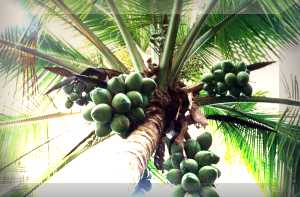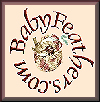 |
Cocos nucifera L.
Family: arecaceae;
Subfamily: arecoideae;
tribe: cocoeae; subtribe: butiinae;
genus: cocos; Common Names: coconut
palm[en], Cocospalme[de], Kokospalme[de]; Name Origins: nucifera:
nux is latin for nut and ferre means to carry |
|
|
|
|
Description: Palm to 27 m or more tall, bearing crown of
large pinnate leaves; trunk stout, 30-45 cm in diameter, straight or
slightly curved, rising from a swollen base surrounded by mass of roots;
rarely branched, marked with rings of leaf scars; leaves 2-6 m long,
pinnatisect, leaflets 0.6-1 m long, narrow, tapering; inflorescence in
axil of each leaf as spathe enclosing a spadix 1.3-2 m long, stout, straw
or orange colored, simply branched; female flowers numerous, small,
sweet-scented, horne towards top of panicle; fruit ovoid, 3-angled, 15-30
cm long, containing single seed; exocarp a thick fibrous, husk, enclosing
a hard, bony endocarp or shell. Adhering inside wall of endocarp is testa
with thick albuminous endosperm, the coconut meat; embryo below one of the
three pores at end of fruit, cavity of endosperm filled in unripe fruit
with watery fluid, the coconut water, and only partially filled.when ripe.
Fl. and fr. year round in tropics. Chemistry: Per 100 g, the kernel is reported to contain 36.3 g H2O 4.5 g protein, 41.6 g fat, 13.0 g total carbohydrate, 3.6 g fiber, 1.0 g ash, 10 mg Ca, 24 mg P, 1.7 mg Fe, and traces of beta-carotene (C.S.I.R., 1948-1976). Per 100 g, the green nut is reported to contain 77-200 calories, 68.0-84.0 g H2O, 1.4- 2.0 g protein, 1.9-17.4 g fat, 4.0-11.7 g total carbohydrate, 0.4-3.7 g fiber, 0.7-0.9 g ash, 11-42 mg Ca, 42-56 mg P, 1.0-1.1 mg Fe, 257 mg K, trace of beta-carotene, 0.4-0.5 mg thiamine, 0.03 mg riboflavin, 0.8 mg niacin, and 6-7 mg ascorbic acid (Food Composition Tables). Coconut oil is one of the least variable among vegetable fats, i.e. 0.2-0.5% caproic-, 5.4-9.5 caprylic-, 4.5-9.7 capric-, 44.1-51.3 lauric-, 13.1-18.5 myristic, 7.5-10.5 palmitic-, 1.0-3.2 stearic-, 0-1.5 arachidic-, 5.0-8.2 oleic-, and 1.0-2.6 linoleic-acids (C.S.I.R., 1948-1976). Following oil extraction from copra, the coconut cake (poonac) contains 10.0-13.3% moisture, 6.0-26.7% oil, 14.3-19.8% protein, 32.8-45.3% carbohydrates, 8.9-12.2% fibers, and 4.0-5.7% ash. The so-called coconut water is 95.5% water, 0.1% protein, <0.1% fat, 0.4% ash, 4.0% carbohydrate. Per 100 g water, there is 105 mg Na, 312 K, 29 Ca, 30 Mg, 0.1 Fe, 0.04 Cu, 37 P, 24 S, and 183 mg choline. Leaves contain 8.45% moisture, 4.282 ash, 0.56% K2O, 0.25 P2O5, 0.28 CaO, and 0.57% MgO. Uses: Coconut is one of the ten most useful trees in the world, providing food for millions of people, especially in the tropics. At any one time a coconut palm has 12 different crops of nuts on it, from opening flower to ripe nut. At the top of the tree is the growing point, a bundle of tightly packed, yellow-white, cabbage-like leaves, which, if damaged, causes entire tree to die, but if tree can be spared, this heart makes a tasty treat, a 'millionaire's salad'. Unopened flowers are protected by sheath, often used to fashion shoes, caps, even a kind of pressed helmet for soldiers. Opened flowers provide a good honey for bees. A clump of unopened flowers may be bound tightly together, bent over and its tip bruised. Soon it begins to 'weep' a steady dripping of sweet juice, up to a gallon per day. It contains 16-30 mg ascorbic acid/100 g. The cloudy brown liquid is easily boiled down to syrup, called coconut molasses, then crystalized into a righ dark sugar, almost exactly like maple sugar. Sometimes it is mixed with grated coconut for candy. Left standing, it ferments quickly into a beer with alcohol content up to 8%, called 'toddy' in India and Sri Lanka; 'tuba' in Philippines and Mexico; and 'tuwak' in Indonesia. After a few weeks, it becomes a vinegar. 'Arrack' is the product after distilling fermented 'toddy' and is a common spirituous liquor consumed in the East. Nut has a husk, which is a mass of packed fibers called coir, which can be woven into strong twine or rope, and is used for padding mattresses, upholstery and life-preservers. Fiber resistant to sea water and is used for cables and rigging on ships, for making mats, rugs, bags, brooms, brushes, and olive oil filters in Italy and Greece; also used for fires and mosquito smudges. If nut is allowed to germinate, cavity fills with a spongy mass called 'bread' which is eaten raw or toasted in shell over fire. Sprouting seeds may be eaten like celery. Shell is hard and fine-grained, and may be carved into all kinds of objects, as drinking cups, dippers, scoops, smoking pipe bowls, and collecting cups for rubber latex. Charcoal used for cooking fires, air filters, in gas masks, submarines, and cigarette tips. Shells burned as fuel for copra kilns or housefires. Coconut shell flour used in industry as filler in plastics. Coconut water is produced by a 5 month old nut, about 2 cups of crystal clear, cool sweet (invert sugars and sucrose) liquid, so pure and sterile that during World War II, it was used in emergencies instead of sterile glucose solution, and put directly into a patient's veins. Also contains growth substances, minerals, and vitamins. Boiled toddy, known as jaggery, with lime makes a good cement. Nutmeat of immature coconuts is like a custard in flavor and consistency, and is eaten or scraped and squeezed through cloth to yield a 'cream' or 'milk' used on various foods. Cooked with rice to make Panama's famous 'arroz con coco'; also cooked with taro leaves or game, and used in coffee as cream. Dried, desiccated, and shredded it is used in cakes, pies, candies, and in curries and sweets. When nuts are cut open and dried, meat becomes copra, which is processed for oil, rich in glycerine and used to make soaps, shampoos, shaving creams, toothpaste lotions, lubricants, hydraulic fluid, paints, synthetic rubber, plastics, margarine, and in ice cream. In India, the Hindus make a vegetarian butter called 'ghee' from coconut oil; also used in infant formulas. When copra is heated, the clear oil separates out easily, and is made this way for home use in producing countries. Used in lamps. Cake residue used as cattle fodder, as it is rich in proteins and sugar; should not give more than 4-5 lbs/animal/day, as butter from milk will have a tallow flavor. As cake is deficient in calcium, it should be fed together with calcium rich foods. Trunk wood used for building sheds and other semi-permanent buildings. Outer wood is close-grained, hard, and heavy, and when well seasoned, has an attractive dark colored grain adaptable for carving, especially ornamentals under the name of 'porcupine wood'. Coconut logs should not be used for fences, as decayed wood makes favorable breeding places for beetles. Logs are used to make rafts. Sections of stem, after scooping out pith, are used as flumes or gutters for carrying water. Pith of stem contains starch which may be extracted and used as flour. Pitch from top of tree is sometimes pickled in coconut vinegar. Coconut leaves made into thin strips are woven into clothing, furnishings, screens, and walls of temporary buildings. Stiff midribs make cooking skewers, arrows, brooms, brushes, and for fish traps. Leaf fiber used in India to make mats, slippers, and bags. Used to make short-lived torches. Coconut roots provide a dye, a mouthwash, a medicine for dysentery, and frayed out make toothburshes; scorched, used as coffee substitute. Believed to be antiblenorrhagic, antibronchitis, febrifugal, and antigingivitic. Coconut palm is useful as an ornamental; its only drawback being the heavy nuts which may cause injury to man, beast, or rooftop when they hit in falling (Duke, 1972). Folk Medicine: According to Hartwell (1967-1971) coconuts are used in folk remedies for tumors. Reported to be anthelmintic, antidotal, antiseptic, aperient, aphrodisiac, astringent, bactericidal, depurative, diuretic, hemostat, pediculicide, purgative, refrigerant, stomachic, styptic, suppurative, and vermifuge, coconut, somewhere or other, is a folk remedy for abscesses, alopecia, amenorrhea, asthma, blenorrhagia, bronchitis, bruises, burns, cachexia, calculus, colds, constipation, cough, debility, dropsy, dysentery, dysmenorrhea, earache, erysipelas, fever, flu, gingivitis, gonorrhea, hematemesis, hemoptysis, jaundice, menorrhagia, nausea, phthisis, pregnancy, rash, scabies, scurvy, sore throat, stomach, swelling, syphylis, toothache, tuberculosis, tumors, typhoid, venereal diseases, and wounds (Duke and Wain, 1981). |
|
|
|
|
|
"At one time, coconut and palm fats and oils received negative press because of their high levels of saturated fats. Unlike the long chain triglycerides found in seed oils and hydrogenated coconut fat, medium chain triglycerides featured in unadulterated coconut and coconut milk do not raise serum cholesterol nor contribute to heart disease." Lauric Acid, Omar Alvarado, Thomas J. Fellers and Michael W. Davidson - National High Magnetic Field Laboratory, |
|
|
|
|




